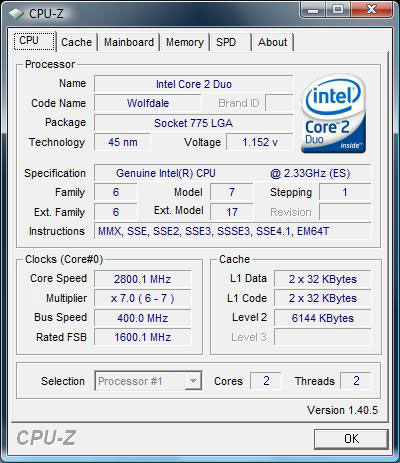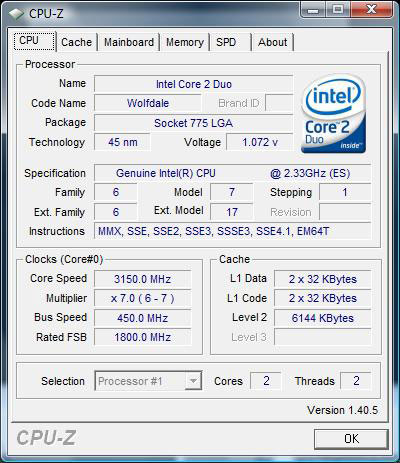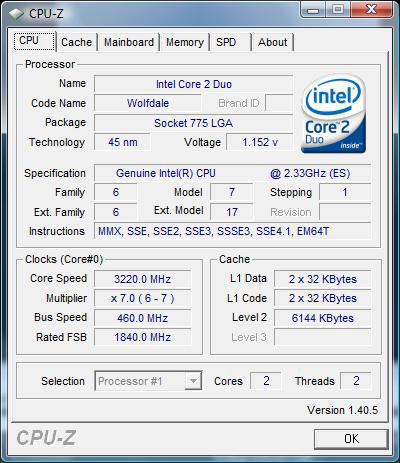The Penryn Preview - Part I: Wolfdale Performance
by Anand Lal Shimpi on August 21, 2007 12:35 PM EST- Posted in
- CPUs
Overclocking
In order to make sure that Intel wasn't having yield issues at 45nm, we wanted to see how far we could push our test chip. With the only multipliers available being 6.0x and 7.0x, we had to rely on FSB overclocking to get us to where we wanted to go. But we made things a little more difficult: we didn't increase CPU core voltage at all.
According to CPU-Z, our Wolfdale sample ran at 1.168V at 2.33GHz. We left the voltage unchanged and went in pursuit of how high of a stable overclock we could get otherwise.
400MHz x 7.0 wasn't a problem at stock voltage:

Neither was 450MHz x 7.0:

The best we could manage without adjusting the core voltage was 460MHz x 7.0, or 3.22GHz:

While this test tells us nothing of overall clock speed headroom of Wolfdale and Penryn in general, it does give us something to hope for.










55 Comments
View All Comments
Affectionate-Bed-980 - Thursday, August 23, 2007 - link
My God. Then maybe they should think about reviews when dealing with NDAs. Just because I didnt have to pay for this article doesn't mean people can't complain.Remember those Conroe reviews done by HardOCP or something that were just GPU limited? Of course people have a right to complain about crappy reviews.
Beenthere - Wednesday, August 22, 2007 - link
Nothing here but ad hype for sure. Intel looks desperate.AnnonymousCoward - Saturday, August 25, 2007 - link
Since when does a process node transition mean the company is desperate??fitten - Thursday, August 23, 2007 - link
Why would Intel be despirate? you think 2GHz Barcelona (which isn't the desktop chip) scares them?coldpower27 - Wednesday, August 22, 2007 - link
Assuming that a E6550 consumes 8-10W at idle and 55W at load which shouldn't be too far off from the proper numbers and is a reasonable estimate.
Then your looking at 3-5W for idle and something like 37W for load, very impressive considering the Wolfdale SKU's on the desktop are going to retain their 65W TDP.
n0nsense - Wednesday, August 22, 2007 - link
wtf ?32bit system performance tests on 64bit hardware ?
lets test it on PII.
if you can't find native 64bit soft for MS, look at real OSes.
need new optimizations ? compile open source programs with new flags enabled.
and one more thing.
compilation test will be very good
johnsonx - Wednesday, August 22, 2007 - link
Ever since this:http://www.dailytech.com/article.aspx?newsid=8313&...">http://www.dailytech.com/article.aspx?n...amp;thre...
I can't help but laugh when I see the first chart on page one.
strikeback03 - Wednesday, August 22, 2007 - link
bwahahaPenryn enhancements indeed
TA152H - Tuesday, August 21, 2007 - link
I somehow remember having an argument with all the dolts that were claiming massive IPC improvements for this core and how hopeless the Barcelona was since it would be against the Penryn. It surely does not look to be impossible to me, not even close. Considering the massive improvements AMD gets over time with their process technology, and large improvements vis-a-vis the K8, this looks to be the most competitive the companies have been for quite some time.Not that I am bad mouthing Intel, they did an amazing job not only increasing the size of the cache, but also lowering the latency. The problem is that so many people were expecting the impossible, and now are disappointed because they really don't know anything about microprocessors. It's not Intel's fault, it's still a great product. Lower power, better performance and smaller size compared to a fantastic processor is something they deserve a lot of credit for. But, it's not going to walk away from the Barcelona, especially on servers.
Higher clock speeds would probably show greater improvement, since it's got a larger cache, and going to four cores would as well, but the reality is, it's not going to be a big improvement on most apps. It's also going to be relatively simple for AMD to increase cache sizes, particularly since they added wait states to the L2 cache so it could be bigger if they chose (again illustrating how amazing Intel was for increasing size and speed).
By the time this processor is out though, AMD will not only have corrected the most egregious speed path problems for Barcelona, but they will also be further along on their 65nm process, and if history is any indication (and it normally is), AMD will do a great job in improving their manufacturing on 65nm. All in all, it's not going to be easy for Intel. Or AMD.
AbRASiON - Tuesday, August 21, 2007 - link
I believe those idiots were hopeful of extremely high clocks actually.It doesn't matter how performance is delivered, 10mhz of ultra optimised CPU or 10ghz of poorly optomised, all we want is speed and AMD is yet to show us the money.